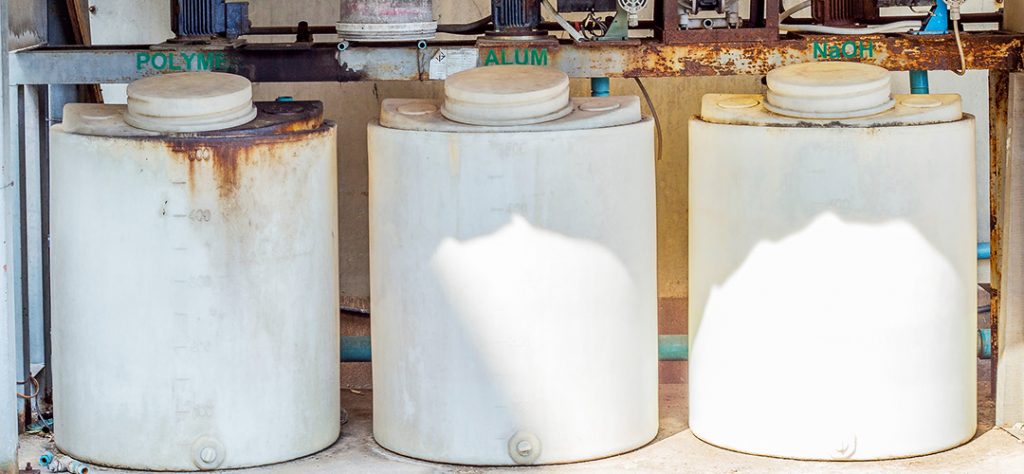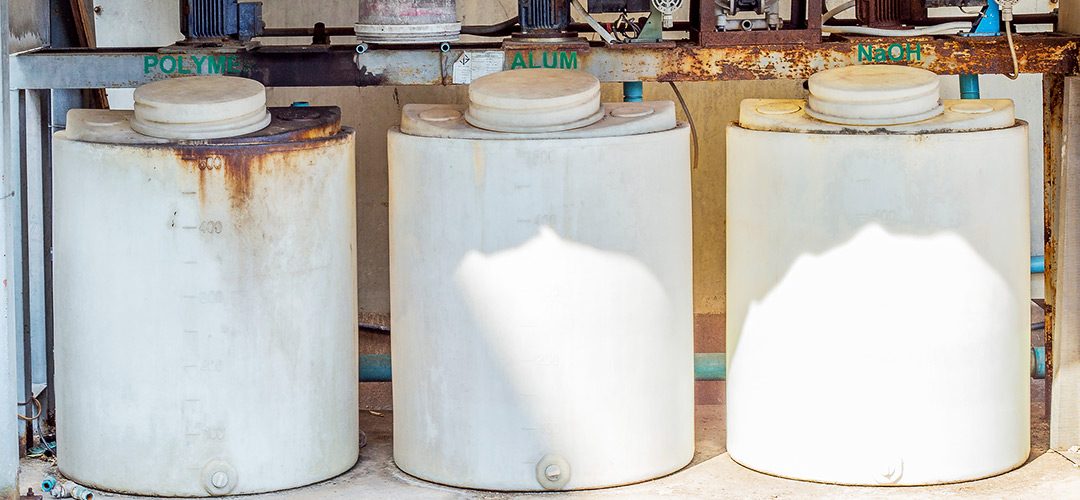Caustic feeds increase in proportion to traditional phosphate removal coagulant dosage.
Due to the low pH and the high quantity of coagulant required, reducing phosphorus using traditional chemicals consumes alkalinity and reduces the pH in the wastewater so low that the normal biological treatment is compromised. This is particularly true of nitrification, which requires alkalinity for the nitrifiers to oxidize ammonia.
To support the biological treatment, which is the backbone of wastewater treatment, plants add alkalinity, usually as caustic, to maintain the pH in the neutral 6 to 8 range required. As the P limit gets lower, the coagulant requirement gets exponentially higher, requiring proportionately more caustic.
But caustic isn’t the only chemical feed that increases with traditional coagulants
Traditional coagulants remove phosphorus by creating a fluffy floc. This floc binds water within the floc, making dewatering more difficult. To break this floc and allow for the removal of some of this bound water requires increased polymer feed. This additional polymer can add significantly to the chemical costs as well as adding some weight to the sludge being dewatered (though not as much as the water removed).
Neo WaterFX selective reaction with phosphorus requires a lower dosage to achieve P limits.
Neo WaterFX uses lanthanide salts that bind preferentially with phosphorus to form a dense crystalline precipitate. Because of this preferential bonding with phosphorus, the amount of chemical required is often a quarter to a tenth of that required for traditional coagulants. The binding is so selective that dosing is straightforward, accurate and predictable, which also simplifies operation and reduces the chemical feed requirement. But the advantages of WaterFX don’t stop with dosing.
WaterFX is less acidic and with the lower dosage consumes very little alkalinity, so no caustic feed is required.
Aluminum sulfate has a pH range of 1.8 to 2.2. Ferric chloride has a pH of around 2.0. WaterFX has a pH of between 3 and 4. Since pH is a logarithmic scale, this means that WaterFX has 1/10th to 1/100th of the acidity of traditional coagulants. Add to that the lower dosage, which is a fourth to a tenth the dosage required with traditional coagulants, and it is easy to see how the acidity added by WaterFX is often 300 to 400 times LESS than that added using traditional metal salts.
With less acidity added, alkalinity is preserved, and the caustic feed can be eliminated in all but the most alkaline deficient wastewaters.
The dense crystalline precipitate produced using WaterFX enhances dewatering, so less polymer is required.
WaterFX binds tightly with phosphorus to form a strong ionic bond that settles quickly and is easily to dewater. In fact, some studies of lanthanide phosphate precipitates show that it actually enhances the dewatering process by making polymer more effective. The net result is that less polymer is required than with any other phosphorus-removing coagulant. In addition to using less polymer, the final sludge product is drier, denser, and less expensive to landfill. These cost benefits add up to significant savings.
Neo WaterFX for reliable phosphorus removal with MUCH less chemical inputs.
Lower dosage, eliminating caustic, and reducing polymer usage all while reducing sludge production and lowering disposal costs – those are just a few of the advantages of switching to Neo WaterFX for your phosphorus removal. Explore all the advantages by visiting: https://neowatertreatment.com/our-products/features-benefits/ .
Then contact us for a free consultation to learn how Neo WaterFX can reduce the chemical feeds in your plant while meeting your P limit.

Using alum for phosphorus removal from wastewater means adding caustic for pH adjustment and additional polymer for dewatering. These chemical feeds can be reduced or eliminated with Neo WaterFX, saving money, and simplifying operations.



